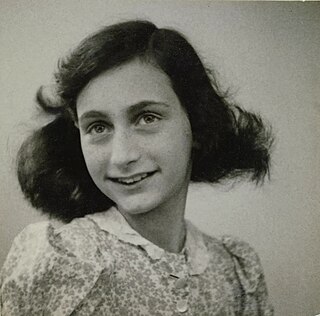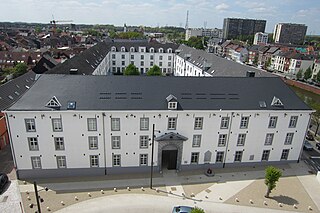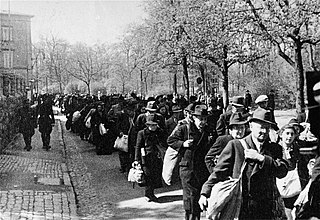Roxane van Iperen | |
|---|---|
 Roxane van Iperen (2018) | |
| Born | 11 June 1976 Nijmegen |
| Alma mater | University of Amsterdam |
Roxane van Iperen (born 11 June 1976) is a Dutch writer and jurist.
Roxane van Iperen | |
|---|---|
 Roxane van Iperen (2018) | |
| Born | 11 June 1976 Nijmegen |
| Alma mater | University of Amsterdam |
Roxane van Iperen (born 11 June 1976) is a Dutch writer and jurist.
Van Iperen attended English secondary school in the Spanish city Málaga from 1990 to 1992. She then moved back to the Netherlands, where she completed her education at the Gymnasium Beekvliet Sint-Michielsgestel in 1995. She studied law at the University of Amsterdam and followed a professional training in the legal profession. From 2001 she worked as a lawyer at NautaDutilh and in the corporate sector. In 2014 she started a journalistic career as a freelance writer for several Dutch newspapers and weeklies. Her first novel (Schuim der aarde) was published in 2016.
Van Iperen's novel t Hooge Nest (2018), based on a true story, was translated in several languages, in English as The Sisters of Auschwitz. The book tells the story of two Jewish sisters’ resistance in Nazi territory. In September 2021, The Sisters of Auschwitz was number 2 of the ‘Nonfiction paperback’ bestsellerlijst and number 5 in the ‘Combined Print & E-Book’ bestseller list of The New York Times ; it also was number 15 of the bestseller list of the American Booksellers Association. [1]

Otto Heinrich Frank was the father of Anne Frank. He edited and published the first edition of her diary in 1947 and advised on its later theatrical and cinematic adaptations. In the 1950s and 60s he established European charities in his daughter's name and founded the trust which preserved his family's wartime hiding place, The Anne Frank House, in Amsterdam.

Annelies MarieFrank was a German-born Jewish girl who kept a diary in which she documented life in hiding under Nazi persecution during the German occupation of the Netherlands. She is a celebrated diarist who described everyday life from her family hiding place in an Amsterdam attic. One of the most-discussed Jewish victims of the Holocaust, she gained fame posthumously with the 1947 publication of The Diary of a Young Girl, in which she documents her life in hiding from 1942 to 1944 - it is one of the world's best-known books and has been the basis for several plays and films.

Jannetje Johanna (Jo) Schaft was a Dutch resistance fighter during World War II. She became known as "the girl with the red hair". Her secret name in the resistance movement was "Hannie".

Margot Betti Frank was the elder daughter of Otto Frank and Edith Frank and the elder sister of Anne Frank. Margot's deportation order from the Gestapo hastened the Frank family into hiding. According to the diary of her younger sister, Anne, Margot kept a diary of her own, but no trace of it has ever been found. She died in Bergen-Belsen concentration camp.

Edith Frank was the mother of Holocaust diarist Anne Frank, and her older sister Margot. After the family were discovered in hiding in Amsterdam during the German occupation, she was transported to Auschwitz-Birkenau concentration camp.
The Holocaust has been a prominent subject of art and literature throughout the second half of the twentieth century. There is a wide range of ways–including dance, film, literature, music, and television–in which the Holocaust has been represented in the arts and popular culture.

The Dutch resistance to the German occupation of the Netherlands during World War II can be mainly characterized as non-violent. The primary organizers were the Communist Party, churches, and independent groups. Over 300,000 people were hidden from German authorities in the autumn of 1944 by 60,000 to 200,000 illegal landlords and caretakers. These activities were tolerated knowingly by some one million people, including a few individuals among German occupiers and military.

Jewish resistance under Nazi rule took various forms of organized underground activities conducted against German occupation regimes in Europe by Jews during World War II. According to historian Yehuda Bauer, Jewish resistance was defined as actions that were taken against all laws and actions acted by Germans. The term is particularly connected with the Holocaust and includes a multitude of different social responses by those oppressed, as well as both passive and armed resistance conducted by Jews themselves.

Renate Ida Rubinstein was a German-Dutch writer, journalist and columnist.
Sara Bosmans-Benedicts was a Dutch pianist and piano pedagogue.

The Mechelen transit camp, officially SS-Sammellager Mecheln in German, also known as the Dossin barracks, was a detention and deportation camp established in a former army barracks at Mechelen in German-occupied Belgium. It served as a point to gather Belgian Jews and Romani ahead of their deportation to concentration and extermination camps in Eastern Europe during the Holocaust.
Marianne "Janny" Brandes-Brilleslijper was a Dutch Holocaust survivor and one of the last people to see Anne Frank. She is the sister of singer Lin Jaldati. Both Brandes-Brilleslijper and Jaldati were in the Westerbork, Auschwitz and Bergen-Belsen concentration camps with Anne and Anne's older sister Margot Frank.

Bloeme Evers-Emden was a Dutch lecturer and child psychologist who extensively researched the phenomenon of "hidden children" during World War II and wrote four books on the subject in the 1990s. Her interest in the topic grew out of her own experiences during World War II, when she was forced to go into hiding from the Nazis and was subsequently arrested and deported to Auschwitz on the last transport leaving the Westerbork transit camp on 3 September 1944. Together with her on the train were Anne Frank and her family, whom she had known in Amsterdam. She was liberated on 8 May 1945.

The Holocaust in the Netherlands was organized by Nazi Germany in occupied Netherlands as part of the Holocaust across Europe during the Second World War. In 1939, there were some 140,000 Jews living in the Netherlands, among them some 24,000 to 25,000 German-Jewish refugees who had fled from Germany in the 1930s. Some 75% of the Dutch-Jewish population was murdered in the Holocaust. The 1947 census reported 14,346 Jews, or 10% of the pre-war population. This further decrease is attributed to massive emigration of Jews to the then British Mandate of Palestine.

Henriëtte Henriquez Pimentel was a Dutch teacher and trained nurse who during the Second World War headed a crèche in Amsterdam which cared for small children while their parents were otherwise occupied. Together with Walter Süskind and Johan van Hulst, from around October 1942 she helped to save the lives of hundreds of Jewish infants by smuggling them into the homes of sympathetic host families. After being arrested by the Nazis in April 1943, she was murdered in the Auschwitz concentration camp the following September.
Catharina Aaltjen Boekbinder was a member of the Dutch Resistance during World War II. Known to family and friends as "Ina Boekbinder," she used the alias, "Catharina Weesing," during her resistance work. In 1981, she was awarded the Verzetsherdenkingskruis by the Dutch government for her work as a freedom fighter and for her efforts to protect Jewish men, women and children in the Netherlands from persecution and deportation by Nazi officials.

The question of how much Germans knew about the Holocaust while it was ongoing continues to be debated by historians. With regard to Nazi Germany, some historians argue that it was an open secret amongst the population, whilst others highlight a possibility that the German population were genuinely unaware of the Final Solution. Peter Longerich argues that the Holocaust was an open secret by early 1943, but some authors place it even earlier. However, after the war, many Germans claimed that they were ignorant of the crimes perpetrated by the Nazi regime, a claim associated with the stereotypical phrase "Davon haben wir nichts gewusst".

Selma van de Perre-Velleman is a Dutch–British resistance fighter. During the Second World War, she worked as a courier, a term that at the time acquired a specific connotation as "messenger of the resistance".

Berta Berkovich Kohút was a Czechoslovakian-born survivor of the Auschwitz concentration camp. By the time of her death in 2021, she was the last surviving seamstress who lived through internment at the camp by creating dresses for the wives of Nazi officers.